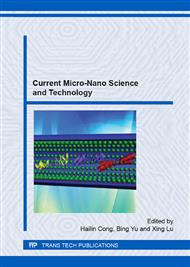[1]
T. Kamimon, J. Nagai, M. Mizuhashi, Electrochromic devices for transmissive and reflective light control, Sol. Energy mater. 16 (1987) 27-38.
DOI: 10.1016/0165-1633(87)90005-0
Google Scholar
[2]
Y. Shigesato, D.C. Paine, A microstructural study of low resistivity tin-doped indium oxide prepared by dc magnetron sputtering, Thin Solid Films. 238 (1994) 44-50.
DOI: 10.1016/0040-6090(94)90646-7
Google Scholar
[3]
Y. Nakato, H. Tsubomura, Silicon photoelectrodes modified with ultrafine metal islands, Electrochim. acta. 37 (1992) 897-907.
DOI: 10.1016/0013-4686(92)85041-i
Google Scholar
[4]
T. Wang, P.V. Radovanovic, Free electron concentration in colloidal indium tin oxide nanocrystals determined by their size and structure, J. Phy Chem. C. 115 (2010) 406-413.
DOI: 10.1021/jp108926a
Google Scholar
[5]
G. Garcia, R. Buonsanti, E.L. Runnerstrom, et al, Dynamically modulating the surface plasmon resonance of doped semiconductor nanocrystals, Nano lett. 11 (2011) 4415-4420.
DOI: 10.1021/nl202597n
Google Scholar
[6]
M. Kanehara, H. Koike, T. Yoshinaga, et al, Indium tin oxide nanoparticles with compositionally tunable surface plasmon resonance frequencies in the near-IR region, J. Am. Chem. Soc. 13 (2009) 17736-17737.
DOI: 10.1021/ja9064415
Google Scholar
[7]
Devi P. Sujatha, M. Chatterjee, D. Ganguli, Indium tin oxide nano-particles through an emulsion technique, Mater. Lett. 55 (2002) 205-210.
DOI: 10.1016/s0167-577x(01)00647-4
Google Scholar
[8]
R.A. Gilstrap, C. J Capozzi, C. G Carson, et al, Synthesis of a nonagglomerated indium tin oxide nanoparticle dispersion. Adv. Mater, 20 (2008) 4163-4166.
DOI: 10.1002/adma.200702556
Google Scholar
[9]
B. Low, F. Zhu, K Zhang, et al, Improvement of hole injection in phenyl-substituted electroluminescent devices by reduction of oxygen deficiency near the indium tin oxide surface, Appl. Phys. lett. 80 (2002) 4659-4661.
DOI: 10.1063/1.1484544
Google Scholar
[10]
S. Y. Kim, J. L. Lee, K. B. Kim, et al, Effect of ultraviolet–ozone treatment of indium–tin–oxide on electrical properties of organic light emitting diodes, J. Appl. Phys. 95 (2004) 2560-2563.
DOI: 10.1063/1.1635995
Google Scholar
[11]
G. Frank, H. Köstlin, Electrical properties and defect model of tin-doped indium oxide layers, Appl. Physics A. 27 (1982): 197-206.
DOI: 10.1007/bf00619080
Google Scholar
[12]
H. Köstlin, R. Jost, W. Lems, Optical and electrical properties of doped In2O3 films, Physica Status Solidi (a). 29 (1975) 87-93.
DOI: 10.1002/pssa.2210290110
Google Scholar
[13]
N. Yamada, I. Yasui, Y. Shigesato, et al, Donor compensation and carrier-transport mechanisms in tin-doped In2O3 films studied by means of conversion electron 119Sn Mössbauer spectroscopy and Hall effect measurements, Jpn. J. Appl. Phys. 39 (2000).
DOI: 10.1143/jjap.39.4158
Google Scholar
[14]
N. Yamada, Y. Shigesato, I. Yasui, et al, Estimation of chemical states and carrier density of Sn-doped In2O3 (ITO) by Mössbauer spectrometry, Hyperfine Interact. 112 (1998) 213-216.
Google Scholar
[15]
N. Nadaud, N. Lequeux, M. Nanot, et al, Structural Studies of Tin-Doped Indium Oxide (ITO) and In4Sn3O12, J. Solid State Chem. 135(1998) 140-148.
DOI: 10.1006/jssc.1997.7613
Google Scholar
[16]
I. Hamberg, C. G. Granqvist, Evaporated Sn-doped In2O3 films: basic optical properties and applications to energy-efficient windows, J. Appl. Phys. 60 (1986): R123-R160.
DOI: 10.1063/1.337534
Google Scholar


